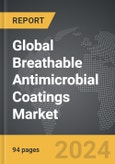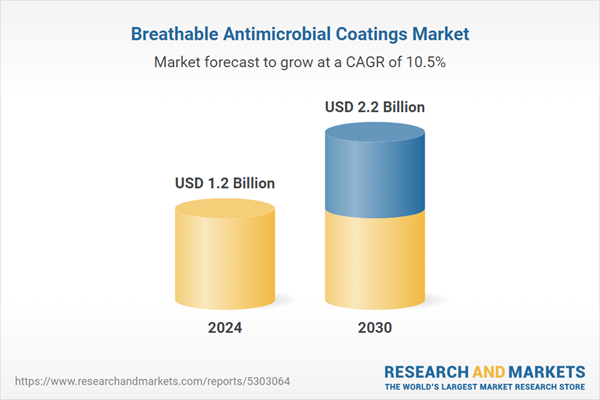Global Breathable Antimicrobial Coatings Market - Key Trends & Drivers Summarized
How Are Breathable Antimicrobial Coatings Revolutionizing Infection Control?
Breathable antimicrobial coatings are revolutionizing infection control by offering surfaces that inhibit microbial growth while allowing moisture and air to pass through. These coatings are particularly valuable in healthcare settings, food processing facilities, and public spaces, where the risk of infection from bacteria, fungi, and viruses is high. Traditional antimicrobial coatings may trap moisture, leading to degradation of the surface or promoting the growth of mold and mildew. Breathable antimicrobial coatings solve this issue by creating a protective barrier that kills or inhibits the growth of harmful pathogens without compromising the breathability of the surface.The technology behind these coatings involves embedding antimicrobial agents, such as silver ions, copper, or other biocides, into a breathable matrix. This ensures that the coating remains effective in preventing microbial growth while allowing air and water vapor to pass through, maintaining the integrity and durability of the coated surface. These coatings are becoming essential in high-traffic areas such as hospitals, schools, and transportation systems, where they provide continuous protection against microbial contamination. As awareness of infection control and hygiene standards grows, the demand for breathable antimicrobial coatings is increasing across multiple industries.
What Role Do Breathable Antimicrobial Coatings Play in Healthcare Settings?
Breathable antimicrobial coatings play a critical role in healthcare settings, where infection prevention and control are of paramount importance. Hospitals and healthcare facilities are breeding grounds for pathogens, and healthcare-associated infections (HAIs) are a significant concern. Surfaces such as walls, floors, medical equipment, and frequently touched areas like door handles and bedrails can harbor bacteria, viruses, and fungi that can spread infections to patients, healthcare workers, and visitors. Breathable antimicrobial coatings help mitigate this risk by providing continuous protection against microbial contamination, reducing the transmission of harmful pathogens.The breathable nature of these coatings ensures that surfaces remain dry and free from mold or mildew, which can thrive in moist environments. Additionally, antimicrobial coatings are designed to be durable and long-lasting, reducing the need for frequent cleaning and reapplication. By incorporating these coatings into the design of healthcare facilities, hospitals can create a safer environment for patients, particularly those with weakened immune systems. The COVID-19 pandemic has further highlighted the importance of infection control in healthcare settings, driving the adoption of antimicrobial coatings that provide an additional layer of defense against pathogens.
How Are Breathable Antimicrobial Coatings Being Used in Commercial and Public Spaces?
Breathable antimicrobial coatings are increasingly being used in commercial and public spaces to enhance hygiene and reduce the spread of infections. High-traffic areas such as airports, shopping malls, schools, public transportation, and office buildings are prone to microbial contamination due to the constant flow of people. Surfaces in these environments, including handrails, touchscreens, counters, and seating, can harbor harmful microorganisms that can be transferred through contact. Applying breathable antimicrobial coatings to these surfaces creates a protective barrier that inhibits microbial growth and reduces the risk of disease transmission.In addition to healthcare and public spaces, the food and beverage industry is adopting antimicrobial coatings to maintain hygiene and safety standards. Food processing plants, kitchens, and packaging facilities require surfaces that can resist bacterial contamination without compromising food safety. Breathable antimicrobial coatings help ensure that surfaces remain sanitary, even in environments where moisture and temperature fluctuations are common. The ability of these coatings to prevent microbial growth while allowing surfaces to breathe makes them ideal for use in refrigeration units, food storage areas, and food contact surfaces. As businesses and public institutions prioritize cleanliness and safety, the demand for breathable antimicrobial coatings is expected to grow.
What Factors Are Driving the Growth of the Breathable Antimicrobial Coatings Market?
The growth of the breathable antimicrobial coatings market is driven by several factors, including the increasing demand for infection control solutions, rising awareness of hygiene standards, and advancements in antimicrobial technologies. In healthcare settings, the need to prevent healthcare-associated infections (HAIs) is a major driver of market growth, as hospitals and clinics seek long-lasting, effective solutions to protect patients and staff from microbial contamination. The COVID-19 pandemic has further accelerated the demand for antimicrobial coatings, as businesses, public institutions, and healthcare facilities adopt additional measures to ensure cleanliness and reduce the spread of infectious diseases.Technological advancements in coating materials and antimicrobial agents are also contributing to the market's expansion. The development of breathable coatings that incorporate advanced antimicrobial agents, such as silver nanoparticles and copper ions, is enhancing the effectiveness and durability of these products. Additionally, the rising awareness of antimicrobial resistance (AMR) is driving interest in coatings that offer continuous protection without contributing to the development of resistant pathogens. As industries such as healthcare, food processing, transportation, and construction prioritize hygiene and safety, the demand for breathable antimicrobial coatings is expected to increase, creating new opportunities for innovation and market growth.
Report Scope
The report analyzes the Breathable Antimicrobial Coatings market, presented in terms of market value (US$ Thousand). The analysis covers the key segments and geographic regions outlined below.- Segments: Type (Inorganic, Organic); Application (Mold Remediation, Indoor Air Quality, Medical Equipment & Laboratories, Fabrics & Geotextiles, Other Applications).
- Geographic Regions/Countries:World; United States; Canada; Japan; China; Europe (France; Germany; Italy; United Kingdom; Spain; Russia; and Rest of Europe); Asia-Pacific (Australia; India; South Korea; and Rest of Asia-Pacific); Latin America (Argentina; Brazil; Mexico; and Rest of Latin America); Middle East (Iran; Israel; Saudi Arabia; United Arab Emirates; and Rest of Middle East); and Africa.
Key Insights:
- Market Growth: Understand the significant growth trajectory of the Inorganic Coatings segment, which is expected to reach US$1.2 Billion by 2030 with a CAGR of a 9.9%. The Organic Coatings segment is also set to grow at 11.2% CAGR over the analysis period.
Why You Should Buy This Report:
- Detailed Market Analysis: Access a thorough analysis of the Global Breathable Antimicrobial Coatings Market, covering all major geographic regions and market segments.
- Competitive Insights: Get an overview of the competitive landscape, including the market presence of major players across different geographies.
- Future Trends and Drivers: Understand the key trends and drivers shaping the future of the Global Breathable Antimicrobial Coatings Market.
- Actionable Insights: Benefit from actionable insights that can help you identify new revenue opportunities and make strategic business decisions.
Key Questions Answered:
- How is the Global Breathable Antimicrobial Coatings Market expected to evolve by 2030?
- What are the main drivers and restraints affecting the market?
- Which market segments will grow the most over the forecast period?
- How will market shares for different regions and segments change by 2030?
- Who are the leading players in the market, and what are their prospects?
Report Features:
- Comprehensive Market Data: Independent analysis of annual sales and market forecasts in US$ Million from 2024 to 2030.
- In-Depth Regional Analysis: Detailed insights into key markets, including the U.S., China, Japan, Canada, Europe, Asia-Pacific, Latin America, Middle East, and Africa.
- Company Profiles: Coverage of players such as Covalon Technologies Ltd., E. I. du Pont de Nemours and Company, Fast Mold Removal, H.B. Fuller Construction Products Inc., IAQM, LLC and more.
- Complimentary Updates: Receive free report updates for one year to keep you informed of the latest market developments.
Some of the 43 companies featured in this Breathable Antimicrobial Coatings market report include:
- Covalon Technologies Ltd.
- E. I. du Pont de Nemours and Company
- Fast Mold Removal
- H.B. Fuller Construction Products Inc.
- IAQM, LLC
- JFB Hart Coatings
- NIKRO Industries Inc.
- Novapura AG
- Paradigm Labs
- Pharmaplast
This edition integrates the latest global trade and economic shifts into comprehensive market analysis. Key updates include:
- Tariff and Trade Impact: Insights into global tariff negotiations across 180+ countries, with analysis of supply chain turbulence, sourcing disruptions, and geographic realignment. Special focus on 2025 as a pivotal year for trade tensions, including updated perspectives on the Trump-era tariffs.
- Adjusted Forecasts and Analytics: Revised global and regional market forecasts through 2030, incorporating tariff effects, economic uncertainty, and structural changes in globalization. Includes historical analysis from 2015 to 2023.
- Strategic Market Dynamics: Evaluation of revised market prospects, regional outlooks, and key economic indicators such as population and urbanization trends.
- Innovation & Technology Trends: Latest developments in product and process innovation, emerging technologies, and key industry drivers shaping the competitive landscape.
- Competitive Intelligence: Updated global market share estimates for 2025, competitive positioning of major players (Strong/Active/Niche/Trivial), and refined focus on leading global brands and core players.
- Expert Insight & Commentary: Strategic analysis from economists, trade experts, and domain specialists to contextualize market shifts and identify emerging opportunities.
Table of Contents
Companies Mentioned (Partial List)
A selection of companies mentioned in this report includes, but is not limited to:
- Covalon Technologies Ltd.
- E. I. du Pont de Nemours and Company
- Fast Mold Removal
- H.B. Fuller Construction Products Inc.
- IAQM, LLC
- JFB Hart Coatings
- NIKRO Industries Inc.
- Novapura AG
- Paradigm Labs
- Pharmaplast
Table Information
| Report Attribute | Details |
|---|---|
| No. of Pages | 283 |
| Published | January 2026 |
| Forecast Period | 2024 - 2030 |
| Estimated Market Value ( USD | $ 1.2 Billion |
| Forecasted Market Value ( USD | $ 2.2 Billion |
| Compound Annual Growth Rate | 10.5% |
| Regions Covered | Global |









